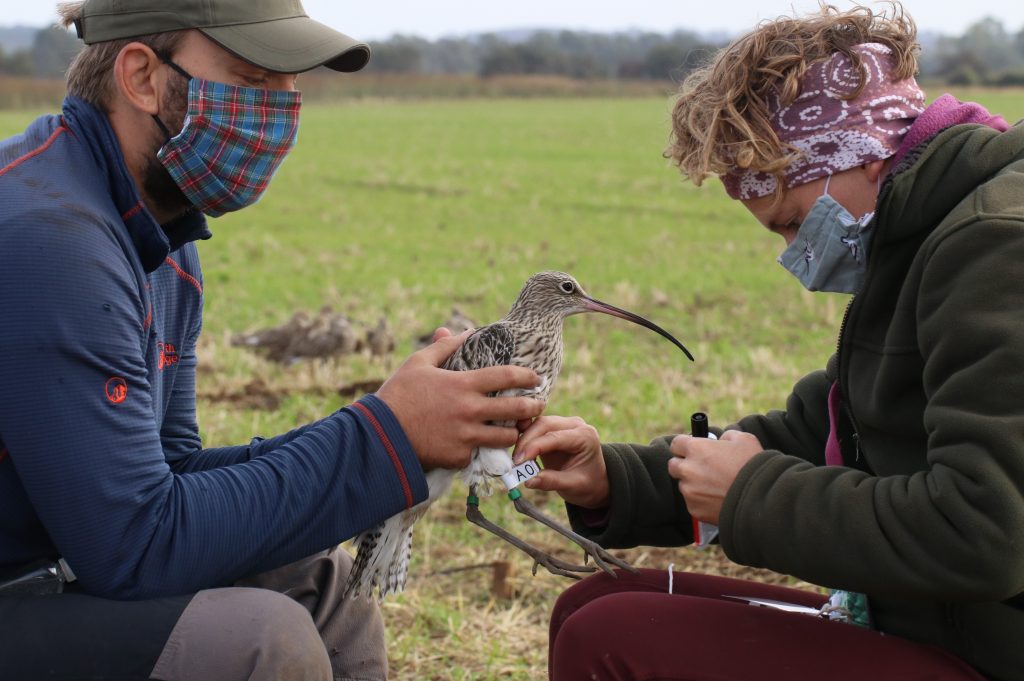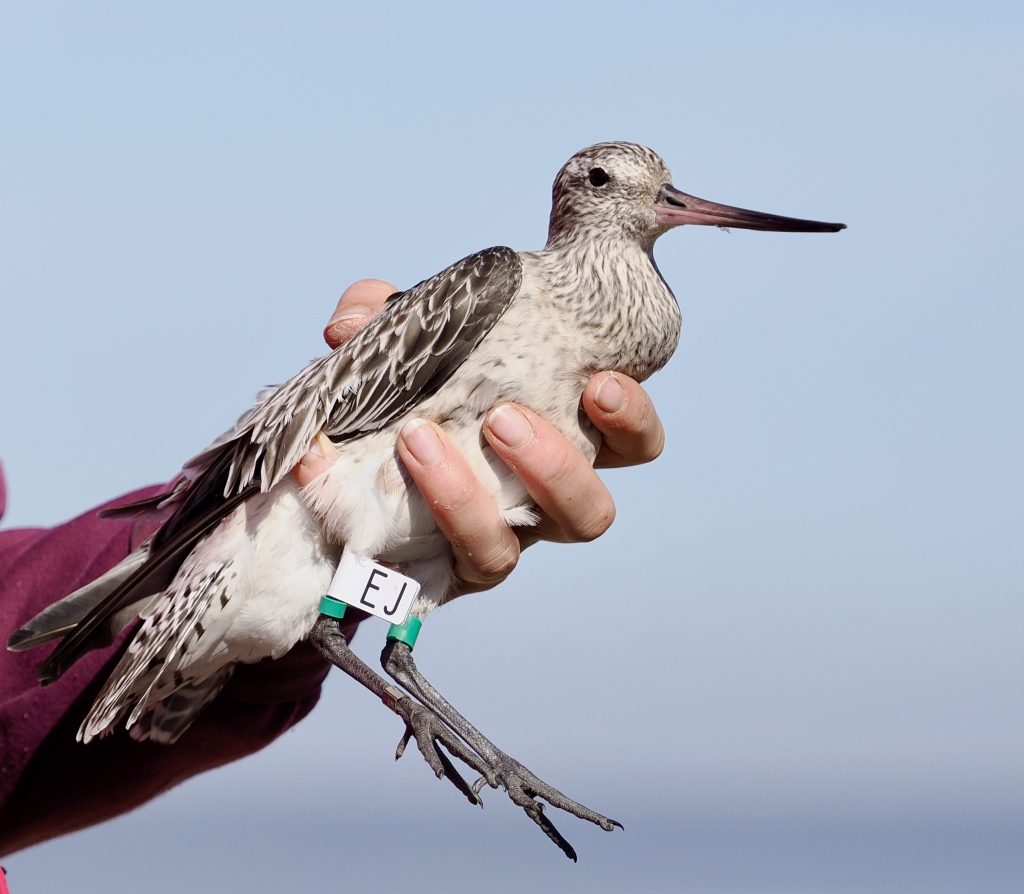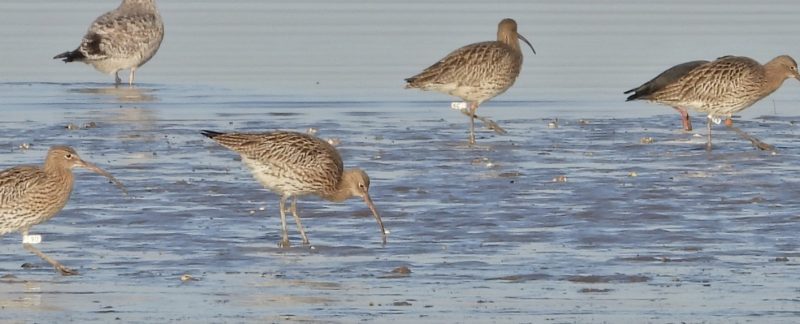If you have taken part in WWRG winter fieldwork over the past twelve years, you know that one tide of each fieldwork weekend is dedicated to resighting colour-marked birds. We have been applying leg flags to Bar-tailed Godwit since 2010, and Curlew since 2012, with over 200 people reporting one or more flag sightings. We use individual leg flags to both add to the survival data generated from metal rings (see Cook et al. 2021) and to look at how individual birds use the Wash and the surrounding area. Our first paper analysing how birds move around within the Wash has just been published in the journal Wader Study (Pell et al. 2023).
The paper used data from over 250 Curlew and 250 Bar-tailed Godwit caught and flagged between August 2014 and October 2018 – the catches involved over 60 different people over at least 12 separate cannon-net catches. So, if you took part in one of these catches, (or have resighted the birds) congratulations and you have contributed to the study!
We looked at data from all Curlew caught by cannon-netting on the Wash between 1987 and 2018 (over 3,500 birds) to determine whether there was a bias in the frequency of males to females caught on different shores of the Wash (West / South / East): so if you took part in any WWRG fieldwork where Curlew were caught and ringed over the past 30 years, congratulations – you have contributed to the study!
A WWRG cannon net catch can begin months in advance, with equipment undergoing regular maintenance and leg flags constructed well ahead of deployment. Liaison with landowners and regulatory authorities is a crucial part of the work. In addition, arranging a team incorporating skilled and highly experienced wader ringers from across the United Kingdom requires dozens of emails and phone calls, as well as pre-planning online meetings.

We reconnoitre possible catch sites to determine where and when a suitable flock is likely to be present (they don’t always do what we expect). Deploying equipment for a successful catch often requires us to be in place hours before the actual catch, which usually occurs around high tide. A typical cannon-net catch of Curlew involves between 16 to 20 people, though we have sometimes ‘man’ multiple adjacent locations to increase catch probability at very high tides which may only occur once a year. This can involve up to 40 people. We aim to ring, flag and take measurements as quickly as possible, with the last birds being released as the falling tide uncovers their feeding areas.
We then clean and put away the equipment ready for subsequent catch attempts. We record data in duplicate, and cross-check everything prior to submission to the BTO. We also send annual returns for each flagging project to BTO licensing, including tallies of the number of resightings made for each project. For this study, over 1,000 Curlew sightings and over 250 Godwit sightings between 2018 and 2020 were included. If you resighted a Curlew or Godwit during this period, congratulations – you have contributed to the study!
Total Bar-tailed Godwit sightings now exceed 2,000 and Curlew over 6,000. Observers with over 500 sightings are a distinct rarity in our group, but these half-dozen members have provided over two-thirds of our data. Hence, we are always keen to develop resighting observers. We are very grateful to Stephen Vickers of the Waterbird colour-marking group who has written an App to our specifications, which allows everyone to record resighting data and provides instant feedback to observers. This has reduced the amount of time expended on handling sighting data and improved data accuracy. Submission of resighting data to the BTO has required many hours of data checking and correction, however given this dataset will almost double the total UK Curlew recoveries, it has been well worth the effort.

Writing up the study itself started during the first phase of the COVID-19 pandemic in 2020, with numerous subsequent revisions and data corrections undertaken before submission for peer review. This involves the ‘paper’ (scientific write up of the study) being reviewed by independent experts, who then recommend any changes, corrections or clarifications to be made before it is published. Once a paper is published, it joins similar studies to form a body of scientific evidence about the ecology of waders. This is important for conservation bodies when making management decisions regarding a site or region.
Our study has demonstrated how Curlew and Bar-tailed Godwit have a bias towards males spending winter on The Wash. We already knew this for Bar-tailed Godwit but repeating the observation strengthens the finding of the previous study. We have described how Wash Curlew use surrounding fields in winter in addition to intertidal mudflats and shown that there is a male bias in the birds that feed inland. Conservation measures currently exist for the estuary, but not the surrounding land. This has prompted additional work using tags which report location information to us via the mobile phone network to explore the use of this ‘functionally linked land’ in more detail. Male-predominant functionally linked land use could result in a greater impact on wintering Curlew populations due to conservation pressures than previously anticipated.
Hopefully, we have demonstrated how years of fieldwork distils into evidence for wader conservation. Continuing the legacy of over sixty years of wader study on The Wash is no mean feat: we must continue to evolve to meet conservation threats to our best habitats for wild birds.
Thanks to Rob Pell for writing this article. Cover image by Cathy Ryden.
References
Cook, A.S.C.P., N.H.K. Burton, S.G. Dodd, S. Foster, R.J. Pell, R.M. Ward, L.J. Wright & R.A. Robinson (2021) Temperature and density influence survival in a rapidly declining migratory shorebird. Biological Conservation 260, 109198.
Pell, R.J., J.A. Clark & R.A. Robinson (2023) Contrasting habitat use between and within Bar-tailed Godwit and Eurasian Curlew wintering on the Wash, England. Wader Study 130, doi:10.18194/ws.00321.

